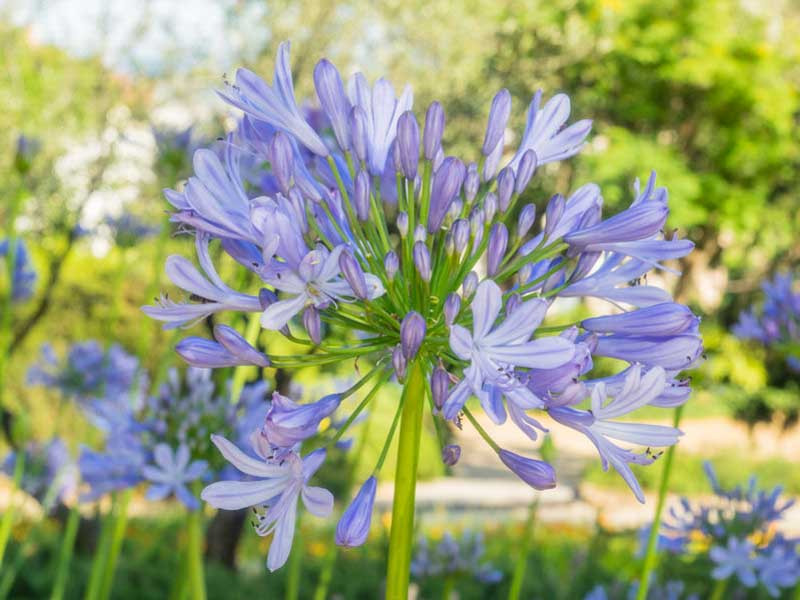Agapanthus Proliferation: Tips for Expanding Your Plant Collection
Agapanthus Proliferation: Tips for Expanding Your Plant Collection
Blog Article
Understanding the Art of Agapanthus Treatment: Necessary Actions for Healthy And Balanced Growth and Vibrant Blooms
In the world of gardening, the farming of agapanthus stands as a rewarding undertaking for those that look for to support these stylish flowering plants. With their striking blossoms and elegant vegetation, agapanthus has actually recorded the focus of garden enthusiasts worldwide. However, attaining optimal growth and dynamic blossoms needs a nuanced method that includes numerous crucial actions. From picking the appropriate range to mastering trimming strategies, the trip in the direction of growing growing agapanthus plants is complex and holds the crucial to opening the full potential of these herb gems.

Selecting the Right Agapanthus Selection

When selecting the ideal Agapanthus range for your garden, think about variables such as climate suitability, flower color, and development behavior. Additionally, take into consideration the environment in your region to make sure the Agapanthus variety you pick can flourish in your specific conditions. Understanding the development practice of various Agapanthus selections is important for proper placement within your yard.
Suitable Growing Conditions
Thinking about the ideal ecological requirements is crucial for effective Agapanthus cultivation. Agapanthus plants are sensitive to cool temperatures and ought to be protected from frost throughout winter season months.
To guarantee healthy and balanced growth and vibrant blooms, plant Agapanthus bulbs at a deepness of concerning 2-4 inches and room them 8-12 inches apart. Mulching around the base of the plants helps retain moisture and suppresses weed development.
Watering and Fertilizing Tips
Maintaining proper dampness levels and providing necessary nutrients are vital aspects in the care routine for Agapanthus plants. When it involves sprinkling Agapanthus, it is vital to strike an equilibrium. These plants like regularly moist dirt yet are at risk to root rot if overwatered. During the growing period, water deeply once a week, ensuring the dirt is well-draining to avoid waterlogging. In hotter environments or during periods of dry spell, even more frequent watering might be essential to maintain the soil uniformly moist. Nonetheless, lower watering in the wintertime to stop water logged problems.
Feeding Agapanthus is crucial for advertising healthy development and prolific blossoms. Apply a well balanced fertilizer, such as a 10-10-10 formula, in the early springtime as brand-new growth arises. Repeat this application every 6-8 weeks throughout the expanding season. Stay clear of excessive fertilizing, as it can cause lush foliage at the expense of blossoms. Always adhere to the maker's instructions for appropriate dilution and application techniques. By following these watering and fertilizing ideas, you can guarantee your Agapanthus plants flourish and generate vibrant, resilient blooms.
Trimming Strategies for Agapanthus
Trimming Agapanthus plants at the suitable times and with correct techniques is important for preserving their health and promoting optimal growth and blooming. The suitable time to trim Agapanthus is in late wintertime or early spring prior to brand-new development emerges. Start by getting rid of any type of dead or yellowing fallen leaves near the base of the plant. Cut them as short as feasible without harming the emerging shoots.
Deadheading invested flowers can likewise redirect the plant's energy right into generating more blossoms rather than establishing seeds. If you want to accumulate seeds for breeding, leave some flowers to mature and completely dry on the plant.
Bear in mind to make use of tidy, Agapanthus sharp devices try this web-site to make specific cuts and decrease the threat of introducing conditions. Agapanthus. Routine pruning will aid keep your Agapanthus looking cool and healthy and balanced while making sure a bountiful display screen of beautiful blossoms
Dealing With Usual Pests and Diseases
After guaranteeing proper pruning strategies for Agapanthus, it is crucial to deal with typical bugs and conditions that can affect the health and vigor of these plants. One typical insect that impacts Agapanthus is the Agapanthus gall midge.
Furthermore, Agapanthus plants can endure from root rot if they are planted in poorly draining pipes soil. By being attentive and taking timely activity against diseases and insects, you can help your Agapanthus plants grow and produce vibrant blossoms. Agapanthus.

Final Thought
Finally, grasping the art of agapanthus treatment involves picking the appropriate selection, giving ideal growing problems, correct watering and feeding, suitable trimming strategies, and resolving typical insects and diseases. By following these vital steps, you can ensure healthy and balanced development and dynamic blooms for your agapanthus plants. Keep in mind to regularly monitor and preserve your plants to promote their total wellness and longevity.
To ensure healthy development and lively flowers, plant Agapanthus bulbs at a deepness of concerning 2-4 inches like it and room them 8-12 inches apart. By complying with these watering and fertilizing tips, you can guarantee your Agapanthus plants thrive and generate lively, lasting blossoms.
One common parasite that impacts Agapanthus is the Agapanthus gall midget. In addition, Agapanthus plants can experience from origin rot if they are planted in inadequately draining pipes soil. By following these crucial steps, you can guarantee healthy growth and lively blooms for your agapanthus plants.
Report this page